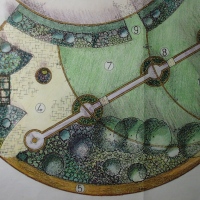There were many beautiful illustrations in the old zoological textbook I wrote about in my last post. Today I’ve picked some illustrious examples of what is known as masquerade or mimesis. Basically, prey animals during evolution developed mechanisms, to camouflage and have higher surveillance rates. Mimetic animals look like something else, not interesting to the predator, like bark, twig, leaf or even lichen. You have the examples on the pictures above, they are actuary full of mother nature’s wit. But could it be presumed, that mimesis is a form of aggressive influential behaviour? Meaning ,that flora in general, is in a way pushing other species to try to survive by being more flora like. Which in turn ends in better surveillance rates of real flora, as the, so to say, fake mimetic subjects de facto are ”incompetent plants”? Would like to hear your opinion about this science-fiction idea!
Archive for 23/01/2014
In play, ‘loose parts’ are skirting the edges of nirvana. Ask any kid. Now they probably won’t call them ‘loose parts’. They’re more likely to use the generic and all encompassing ‘stuff’ prefaced by cool, awesome, or great. It might even go the way of ‘this stuff is epic’.
 Students at Emmaus Primary Catholic School – Melbourne, Australia. Photo: Jay Town. Source: HeraldSun
Students at Emmaus Primary Catholic School – Melbourne, Australia. Photo: Jay Town. Source: HeraldSun
Wood, rope, tarps, tires, milk crates, cardboard boxes, fabrics and apparently hay bales too can make up a loose parts inventory. It’s what the kids do with it that’s a real blast. They create, they build up and pull down, they improvise, they move, groove and PLAY!
Now, thanks to Australian researcher Brendon P. Hyndman we have empirical evidence that loose parts in primary schools go way beyond a good thing. From the perspective of increasing physical activity, engaging a broad cross-section of kids and being light…
View original post 459 more words
With Spring round the corner and thoughts of summer-flowering bulbs, this week’s timely question comes from George White of Walthamstow, London:
‘A friend has some magnificent border plants which he knows only by the name Foxtail Lilies. What are they, and are they easy to grow?’
George, these plants are a glorious addition to summer borders and belong to the genus Eremurus. They are also known as ‘Desert Candles’ and are hardy herbaceous perennials in which tall spikes of star-shaped flowers arise from a ring of narrow, pointed foliage. The best and tallest are the series known as ‘Shelford Hybrids’, whose flowers vary in colour but are often a pleasing soft, pinky beige. They can reach 2.75 metres tall and bear hundreds of primrose-sized flowers.
Eremurus stenophyllus bungei is the yellow-flowered parent of these hybrids and reaches 1 metre in height. The other parent E. olgae, is late flowering, bears pink blooms, and reaches a height of 1.5 metres.
Other fine examples are the very tall E. elwesii with soft pink flowers (and it’s white-flowered variety ‘Albus’), and the even taller (up to 3 metres) E. robustus with pinky yellow flowers on spikes up to 1.2 metres long. Eremurus are quite easy to grow as long as they have a free draining soil around their roots and have lots of warm sunshine. Here’s a video on how to plant Eremurus bulbs. It will probably be at least one season before you see any flowers.


















